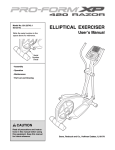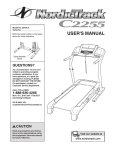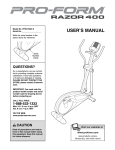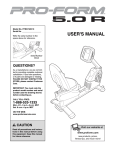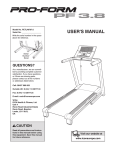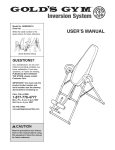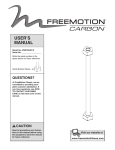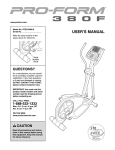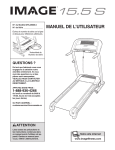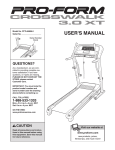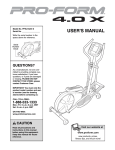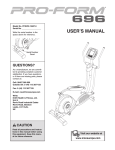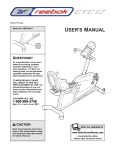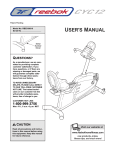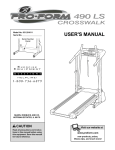Download ProForm Razor 831.23743.0 User's Manual
Transcript
Model No. 831.23743.0 Serial No. Write the serial number in the space above for reference. ELLIPTICAL EXERCISER User’s Manual Serial Number Decal • Assembly • Operation • Maintenance • Part List and Drawing CAUTION Read all precautions and instructions in this manual before using this equipment. Keep this manual for future reference. Sears, Roebuck and Co., Hoffman Estates, IL 60179 TABLE OF CONTENTS WARNING DECAL PLACEMENT . . . . . . . . . . . . . . . . . . . . . . . . . . . . . . . . . . . . . . . . . . . . . . . . . . . . . . . . . . . . . .2 IMPORTANT PRECAUTIONS . . . . . . . . . . . . . . . . . . . . . . . . . . . . . . . . . . . . . . . . . . . . . . . . . . . . . . . . . . . . . . . .3 BEFORE YOU BEGIN . . . . . . . . . . . . . . . . . . . . . . . . . . . . . . . . . . . . . . . . . . . . . . . . . . . . . . . . . . . . . . . . . . . . . .4 ASSEMBLY . . . . . . . . . . . . . . . . . . . . . . . . . . . . . . . . . . . . . . . . . . . . . . . . . . . . . . . . . . . . . . . . . . . . . . . . . . . . . . .5 HOW TO USE THE ELLIPTICAL EXERCISER . . . . . . . . . . . . . . . . . . . . . . . . . . . . . . . . . . . . . . . . . . . . . . . . . .12 MAINTENANCE AND TROUBLESHOOTING . . . . . . . . . . . . . . . . . . . . . . . . . . . . . . . . . . . . . . . . . . . . . . . . . . .19 EXERCISE GUIDELINES . . . . . . . . . . . . . . . . . . . . . . . . . . . . . . . . . . . . . . . . . . . . . . . . . . . . . . . . . . . . . . . . . . .20 PART LIST . . . . . . . . . . . . . . . . . . . . . . . . . . . . . . . . . . . . . . . . . . . . . . . . . . . . . . . . . . . . . . . . . . . . . . . . . . . . . .24 EXPLODED DRAWING . . . . . . . . . . . . . . . . . . . . . . . . . . . . . . . . . . . . . . . . . . . . . . . . . . . . . . . . . . . . . . . . . . . .26 ORDERING REPLACEMENT PARTS . . . . . . . . . . . . . . . . . . . . . . . . . . . . . . . . . . . . . . . . . . . . . . . . . .Back Cover 90 DAY FULL WARRANTY . . . . . . . . . . . . . . . . . . . . . . . . . . . . . . . . . . . . . . . . . . . . . . . . . . . . . . . . . .Back Cover WARNING DECAL PLACEMENT The warning decal shown here has been applied in the location shown. If the decal is missing or illegible, call 1-888-533-1333 and request a free replacement decal. Apply the decal in the location shown. Note: The decal may not be shown at actual size. PROFORM is a registered trademark of ICON IP, Inc. 2 IMPORTANT PRECAUTIONS WARNING: To reduce the risk of serious injury, read all important precautions and instructions in this manual and all warnings on your elliptical exerciser before using your elliptical exerciser. Sears assumes no responsibility for personal injury or property damage sustained by or through the use of this product. 1. Before beginning any exercise program, consult your physician. This is especially important for persons over the age of 35 or persons with pre-existing health problems. 8. Wear appropriate exercise clothes when exercising; do not wear loose clothes that could become caught on your elliptical exerciser. Always wear athletic shoes for foot protection. 2. It is the responsibility of the owner to ensure that all users of the elliptical exerciser are adequately informed of all precautions. 9. Hold the handgrip pulse sensor or the upper body arms when mounting, dismounting, or using your elliptical exerciser. 3. Your elliptical exerciser is intended for home use only. Do not use your elliptical exerciser in a commercial, rental, or institutional setting. 10. Keep your back straight while using your elliptical exerciser; do not arch your back. 11. The pulse sensor is not a medical device. Various factors, including the user’s movement, may affect the accuracy of heart rate readings. The pulse sensor is intended only as an exercise aid in determining heart rate trends in general. 4. Keep your elliptical exerciser indoors, away from moisture and dust. Place your elliptical exerciser on a level surface, with a mat beneath it to protect the floor or carpet. Make sure that there is enough clearance around your elliptical exerciser to mount, dismount, and use it. 12. When you stop exercising, allow the pedals to slowly come to a stop. 5. Inspect and properly tighten all parts regularly. Replace any worn parts immediately. 13. If you feel pain or dizziness while exercising, stop immediately and cool down. 6. Keep children under age 12 and pets away from your elliptical exerciser at all times. 14. Use your elliptical exerciser only as described in this manual. 7. Your elliptical exerciser should not be used by persons weighing more than 250 lbs. (113 kg). 3 BEFORE YOU BEGIN Thank you for purchasing the revolutionary PROFORM® XP 420 Razor elliptical exerciser. The XP 420 Razor elliptical exerciser provides a wide array of features designed to make your workouts at home more effective and enjoyable. cover of this manual. To help us assist you, note the product model number and serial number before contacting us. The model number and the location of the serial number decal are shown on the front cover of this manual. For your benefit, read this manual carefully before you use the elliptical exerciser. If you have questions after reading this manual, please see the back Before reading further, please familiarize yourself with the parts that are labeled in the drawing below. Fan Upper Body Arm Console Pulse Sensor Water Bottle Holder* Wheel Pedal Disc Pedal Adjustment Knob *No water bottle is included 4 ASSEMBLY Assembly requires two persons. Place all parts of the elliptical exerciser in a cleared area and remove the packing materials. Do not dispose of the packing materials until assembly is completed. Assembly requires the included hex keys and your own Phillips screwdriver wrench , and rubber mallet . , adjustable As you assemble the elliptical exerciser, use the drawings below to identify small parts. The number in parentheses below each drawing is the key number of the part, from the PART LIST on pages 24 and 25. The number following the parentheses is the quantity needed for assembly. Note: Some small parts may have been preassembled. If a part is not in the parts bag, check to see if it has been preassembled. If a part is missing, call 1-888-533-1333. M6 Nylon Locknut (77)–4 M4 x 16mm Screw (84)–12 Wave Washer (88)–2 M4 x 16mm Flat Head Screw (94)–4 M10 Split Washer (78)–10 M4 x 32mm Screw (95)–2 M10 x 20mm Button Screw (79)–4 M6 x 16mm Button Screw (80)–6 M10 x 70mm Button Screw (75)–6 5 M10 x 35mm Shoulder Screw (63)–2 M6 x 38mm Button Bolt (76)–4 1. 1 To make assembly easier, read the information on page 5 before you begin assembling the elliptical exerciser. Identify the Left Frame Cover (48), which is marked with an “L” sticker. Orient the Left and Right Frame Covers (48, 49) with the rounded sides in the indicated locations. 48 While another person lifts the rear of the Frame (1), attach each Frame Cover (48, 49) to the Frame with two M4 x 16mm Screws (84). Rounded Side Rounded Side 84 1 49 84 2. Attach a Wheel (50) to the front of the Frame (1) with an M10 x 35mm Shoulder Screw (63). 2 63 50 Repeat this step to attach the other Wheel (50). 1 50 63 6 3. Tip: Be careful not to pinch the Wire Harness (100) during this step. Start all screws before tightening any of them. 3 Wire Tie Have another person hold the Upright (2) near the Frame (1). Locate the wire tie in the Upright. Tie the lower end of the wire tie to the Wire Harness (100). Next, pull the upper end of the wire tie upward out of the top of the Upright. Then, untie and discard the wire tie. Tip: To prevent the Wire Harness from falling inside the Upright (2), secure the Wire Harness with a rubber band. Avoid pinching the Wire Harness (100) during this step 2 Attach the Upright (2) to the Frame (1) with four M10 x 20mm Button Screws (79), and four M10 Split Washers (78). Tip: Tighten the two Button Screws on the front of the elliptical exerciser before tightening the other two Button Screws. 79 78 78 79 78 100 79 1 4. Tip: Be careful not to pinch the Wire Harness (100) during this step. 4 3 Orient the Bottle Holder (5) as shown and slide it onto the Upright (2). Attach the Bottle Holder with two M4 x 32mm Screws (95). 96 100 Slide the Console Cover (96) onto the Upright (2) and move it downward to the Bottle Holder. Then, insert the Console Bracket (3) into the top of the Upright. Attach the Console Bracket with four M4 x 16mm Screws (84). 84 84 2 5 95 7 5. The Console (4) can be operated with four 1.5V “D” batteries (not included); alkaline batteries are recommended. IMPORTANT: If the elliptical exerciser has been exposed to cold temperatures, allow it to warm to room temperature before inserting batteries into the Console. If you do not do this, the console displays or other electronic components may become damaged. Remove the two screws from the back of the console, and remove the battery cover. Insert four batteries into the Console. Orient the batteries as shown by the markings inside the battery compartment. Then, reattach the battery cover. 5 Cover 4 Screws Batteries The Console (4) can also be operated with a regulated 6-volt DC 2-amp power supply (not included). To purchase a power supply, call your local Sears store. To avoid damaging the console, use only a manufacturer-supplied power supply. Plug one end of the power supply into the jack on the Console; plug the other end into an outlet installed in accordance with all local codes and ordinances. 6. Tip: Be careful not to pinch the wires during this step. 6 4 While a second person holds the Console (4) near the Upright (2), connect the console wire to the Wire Harness (100). Console Wire Attach the Console (4) with four M4 x 16mm Flat Head Screws (94). 100 2 96 94 94 8 7. Slide the Console Cover (96) (see the drawing in step 6) upward to the Console (4). Attach the Console Cover with two M4 x 16mm Screws (84). 7 4 96 84 8. Attach the Left Pedal (12) to the left Pedal Arm (14) with three M10 x 70mm Button Screws (75), three Split Washers (78), and an M4 x 16mm Screw (84). 8 14 Repeat this step on the right side of the elliptical exerciser. 78 12 78 75 84 14 13 9 9. Identify the Left Upper Body Arm (8), which is marked with an “L” sticker. Orient the Left Upper Body Arm and the left Upper Body Leg (6) as shown; make sure that the hexagonal holes in the Left Upper Body Arm are in the indicated location. 9 8 Slide the Left Upper Body Arm (8) onto the left Upper Body Leg (6). Attach the Left Upper Body Arm with two M6 x 38mm Button Bolts (76) and two M6 Nylon Locknuts (77); make sure that the Nylon Locknuts are inside the hexagonal holes. 77 76 Repeat this step for the Right Upper Body Arm and the right Upper Body Leg (not shown). Hexagonal Holes 6 10. Apply a generous amount of the included grease to the Pivot Axle (16). Then, apply a small amount of grease to two Wave Washers (88). 10 Insert the Pivot Axle (16) into the Upright (2). Place a Wave Washer (88) on each end of the Pivot Axle. 2 80 Slide the left Upper Body Leg (6) onto the Pivot Axle (16). Attach the left Upper Body Leg with an M6 x 16mm Button Screw (80) and a Large Axle Cover (20). Attach the right Upper Body Leg (6) in the same way. 20 16 6 88 20 80 88 Grease 6 10 11. Apply a small amount of grease to a Pedal Arm Axle (21). While another person holds the right Pedal Arm (14) inside the bracket on the right Upper Body Leg (6), insert the Pedal Arm Axle through the Upper Body Leg and the Pedal Arm. 11 6 14 6 80 Grease 21 22 Then, tighten an M6 x 16mm Button Screw (80) and an Axle Cover (22) into each end of the Pedal Arm Axle (21). 22 80 14 Repeat this step for the other side of the elliptical exerciser. 12. Make sure that all parts of the elliptical exerciser are properly tightened. Note: Some hardware may be left over after assembly is completed. To protect the floor or carpet from damage, place a mat under the elliptical exerciser. 11 HOW TO USE THE ELLIPTICAL EXERCISER HOW TO MOVE THE ELLIPTICAL EXERCISER HOW TO EXERCISE ON THE ELLIPTICAL EXERCISER To move the elliptical exerciser, stand in front of it, place one foot against one of the wheels, and firmly hold the upper end of the upright. Pull the upright forward until you can move the elliptical exerciser on the wheels. Carefully move the elliptical exerciser to the desired location and then lower it to the floor. To decrease the risk of injury, do not attempt to move the elliptical exerciser over an uneven surface. To mount the elliptical exerciser, hold the upper body arms and step onto the pedal that is in the lowest position. Next, step onto the other pedal. Push the pedals until they begin to move with a continuous motion. Note: The crank arms can turn in either direction. It is recommended that you turn the crank arms in the direction shown by the arrow below; however, for variety you can turn the crank arms in the opposite direction. To dismount the elliptical exerciser, wait until the pedals come to a complete stop. Note: The elliptical exerciser does not have a free wheel; the pedals will continue to move until the flywheel stops. When the pedals are stationary, step off the higher pedal first. Then, step off the lower pedal. Upright Upper Body Arms Place your foot here Wheel Pedals Crank Arm 12 HOW TO ADJUST THE STRIDE OF THE ELLIPTICAL EXERCISER Crank Arm To adjust the stride of the elliptical exerciser, first pull one of the adjustment knobs until the adjustment bracket pivots freely. Pivot the adjustment bracket until the adjustment knob is aligned with one of the holes in the crank arm, and gently release the knob. Then, pivot the adjustment bracket back and forth slightly to make sure that the adjustment pin is engaged in one of the holes in the crank arm. Holes Adjust the other side of the elliptical exerciser in the same way. Adjustment Knob Adjustment Pin 13 Adjustment Bracket CONSOLE DIAGRAM The console also offers four preset workouts. Each preset workout automatically changes the resistance of the pedals and prompts you to increase or decrease your pedaling pace as it guides you through an effective workout. FEATURES OF THE CONSOLE The advanced console offers an array of features designed to make your workouts more effective and enjoyable. When you use the manual mode of the console, you can change the resistance of the pedals with the touch of a button. As you exercise, the console will provide continuous exercise feedback. You can even measure your heart rate using the handgrip pulse sensor. To use the manual mode of the console, follow the steps beginning on page 15. To use a target tone workout, see page 17. To use a preset workout, see page 18. The console features two target tone workouts designed to work specific areas of the body. The console guides you through each workout with a variety of exercise instructions while automatically changing the resistance of the pedals. 14 HOW TO USE THE MANUAL MODE The lower left display–This display can show the elapsed time and the approximate number of calories you have burned. Note: During a workout, the display will show the time remaining in the workout. Note: If there is a sheet of clear plastic on the face of the console, remove the plastic. 1. Press the Display button or the decrease button on the console, or begin pedaling to turn on the console. The upper middle display–This display will show the resistance level of the pedals for a few seconds each time the resistance level changes. This display will also show your heart rate when you use the handgrip pulse sensor (see step 5 on page 16). When you turn on the console, the display will light. A tone will then sound and the console will be ready for use. 2. Select the manual mode. When you turn on the console, the manual mode will be selected. If you have selected a workout, reselect the manual mode by pressing the Workouts button repeatedly until the words MANUAL MODE appear in the display. The lower middle display–This display will show a track representing 640 revolutions. As you exercise, indicaTrack tors will appear in succession around the track until the entire track appears. The track will then disappear and the indicators will again begin to appear in succession. The upper right display–This display can show the distance you have pedaled (in total revolutions) and your pedaling pace (in revolutions per minute). 3. Begin pedaling and change the resistance of the pedals as desired. As you pedal, change the resistance of the pedals by pressing the increase and decrease buttons. Note: After you press the buttons, it will take a moment for the pedals to reach the selected resistance level. The lower right display–This display can show your pedaling pace (in revolutions per minute) and the distance you have pedaled (in total revolutions). 4. Follow your progress with the display. The upper left display–This display can show the approximate number of calories you have burned and the elapsed time. To view selected information at a larger size, press the Display button repeatedly until the desired information appears in the lower left and lower right displays. 15 5. Measure your heart rate if desired. If your heart rate is not shown, make sure that your hands are positioned as described. Be careful not to move your hands excessively or to squeeze the metal contacts tightly. For optimal performance, clean the metal contacts using a soft cloth; never use alcohol, abrasives, or chemicals to clean the contacts. If there are sheets of clear Contacts plastic on the metal contacts on the handgrip pulse sensor, remove the plastic. In addition, make sure that your hands are clean. To measure your heart rate, hold the handgrip pulse sensor with your palms resting against the metal contacts. Avoid moving your hands or gripping the contacts tightly. 6. Turn on the fan if desired. The fan has high and low speed settings. Press the Fan button repeatedly to select a fan speed or to turn off the fan. Note: If the pedals do not move for about thirty seconds, the fan will turn off automatically. 7. When you are finished exercising, the console will turn off automatically. When your pulse is detected, a heart-shaped symbol will flash in the display, one or two dashes will appear, and then your heart rate will be shown. For the most accurate heart rate reading, hold the contacts for at least 15 seconds. If the pedals do not move for several seconds, a series of tones will sound, the console will pause, and the time will flash in the display. If the pedals do not move for about five minutes, the console will turn off and the display will be reset. 16 HOW TO USE A TARGET TONE WORKOUT You will also be prompted to keep your pedaling pace near the target pace setting for the current segment. When the TOO SLOW indicator is lit, increase your pace. When TOO FAST indicator is lit, decrease your pace. When the center indicator is lit, maintain your current pace. Important: The target pace settings are intended only to provide motivation. Make sure to pedal at a pace that is comfortable for you. 1. Turn on the console. See step 1 on page 15. 2. Select a target tone workout. To select a target tone workout, press the Workouts button repeatedly until the words TARGET TONE 1 or TARGET TONE 2 appear in the display. When you select a target tone workout, the name of the workout and the workout time will appear in the display. A profile of the resistance levels of the workout will also scroll across the display. If the resistance level for the current segment is too high or too low, you can manually override the setting by pressing the decrease and increase buttons. However, when the current segment ends, the pedals will automatically adjust to the resistance level for the next segment. If you stop pedaling for several seconds, a series of tones will sound and the workout will pause. To restart the workout, simply resume pedaling. The workout will continue until the last segment of the profile flashes and the last segment of the workout ends. Profile 3. Begin pedaling to start the workout. Each workout is divided into 30 one-minute segments. One resistance level and one target pace setting are programmed for each segment. Note: The same resistance level and/or target pace setting may be programmed for two or more consecutive segments. When the workout is completed, the words PROGRAM DONE will appear in the display for a few seconds. Note: If you continue to pedal after the workout is completed, the display will continue to show exercise feedback; however, the display will not show the elapsed time until you select the manual mode or a new workout. During the workout, the workout profile will show your progress (see the drawing above). The flashing segment of the profile represents the current segment of the workout. The height of the flashing segment indicates the resistance level for the current segment. At the end of each segment of the workout, a series of tones will sound and the next segment of the profile will begin to flash. If a different resistance level is programmed for the next segment, the resistance level will flash in the display for a few seconds to alert you. The resistance of the pedals will then change. 4. Follow your progress with the display. See step 4 on page 15. 5. Measure your heart rate if desired. See step 5 on page 16. 6. Turn on the fan if desired. See step 6 on page 16. As you exercise, the console will display a variety of exercise instructions that will help you get the most benefit from your workout. For example, the console may instruct you to PEDAL BACKWARD, USE UPPER BODY, or FOCUS LOWER BODY during certain segments of the workout. 7. When you are finished exercising, the console will turn off automatically. See step 7 on page 16. 17 HOW TO USE A PRESET WORKOUT lit, decrease your pace. When the center indicator is lit, maintain your current pace. Important: The target pace settings are intended only to provide motivation. Make sure to pedal at a pace that is comfortable for you. 1. Turn on the console. See step 1 on page 15. 2. Select a preset workout. To select a preset workout, press the Workouts button repeatedly until the name of the desired workout appears in the display. If the resistance level for the current segment is too high or too low, you can manually override the setting by pressing the decrease and increase buttons. However, when the current segment ends, the pedals will automatically adjust to the resistance level for the next segment. When you select a preset workout, the name of the workout will appear in the display and a profile of the resistance levels of the workout will scroll across the matrix. If you stop pedaling for several seconds, a series of tones will sound and the workout will pause. To restart the workout, simply resume pedaling. The workout will continue until the last segment of the profile flashes and the last segment of the workout ends. Profile 3. Begin pedaling to start the workout. When the workout is completed, the words PROGRAM DONE will appear in the display for a few seconds. Note: If you continue to pedal after the workout is completed, the display will continue to show exercise feedback; however, the display will not show the elapsed time until you select the manual mode or a new workout. Each workout is divided into 20, 30, or 45 oneminute segments. One resistance level and one target pace setting are programmed for each segment. Note: The same resistance level and/or target pace setting may be programmed for two or more consecutive segments. 4. Follow your progress with the display. During the workout, the workout profile will show your progress (see the drawing above). The flashing segment of the profile represents the current segment of the workout. The height of the flashing segment indicates the resistance level for the current segment. At the end of each segment of the workout, a series of tones will sound and the next segment of the profile will begin to flash. If a different resistance level is programmed for the next segment, the resistance level will flash in the display for a few seconds to alert you. The resistance of the pedals will then change. See step 4 on page 15. 5. Measure your heart rate if desired. See step 5 on page 16. 6. Turn on the fan if desired. See step 6 on page 16. 7. When you are finished exercising, the console will turn off automatically. You will also be prompted to keep your pedaling pace near the target pace setting for the current segment. When the TOO SLOW indicator is lit, increase your pace. When TOO FAST indicator is See step 7 on page 16. 18 MAINTENANCE AND TROUBLESHOOTING Inspect and tighten all parts of the elliptical exerciser regularly. Replace any worn parts immediately. until the console displays correct feedback. When the Reed Switch is correctly adjusted, reattach the side shields. Note: If you have questions as to which screw should be in which hole, see EXPLODED DRAWING B on page 27 and the PART LIST on page 24. To clean the elliptical exerciser, use a damp cloth and a small amount of mild soap. Important: To avoid damage to the console, keep liquids away from the console and keep the console out of direct sunlight. HOW TO ADJUST THE BELT If you can feel the pedals slip while you are pedaling, even when the resistance of the pedals is at the highest setting, the Belt (46) may need to be adjusted. First, remove all the screws from both side shields; there are three sizes of screws in the side shields—note which size of screw you remove from each hole. Then, gently pry the side shields away from the frame. BATTERY REPLACEMENT If the console displays become dim, the batteries should be replaced; most console problems are the result of low batteries. See assembly step 5 on page 8 for replacement instructions. HANDGRIP PULSE SENSOR TROUBLESHOOTING Next, turn the Belt Adjustment Screw (72) until 46 the Belt (46) is tight. Then, reattach the side shields. Note: If you have questions as to which 72 screw should be in which hole, see EXPLODED DRAWING B on page 27 and the PART LIST on page 24. If the handgrip pulse sensor does not function properly, see step 5 on page 16. HOW TO ADJUST THE REED SWITCH If the console does not display correct feedback, the reed switch should be adjusted. First, remove all of the screws from both side shields; there are three sizes of screws in the side shields—note which size of screw you remove from each hole. Then, gently pry the side shields away from the frame. Next, locate the Reed Switch (58). Turn the Left 41 26 58 Pedal Disc (26) 84 until the Magnet (41) is aligned with the Reed Switch. Loosen, but do not remove, the indicated M4 x 16mm Screw (84). Slide the Reed Switch slightly closer to or away from the Magnet, and then retighten the Screw. Rock the Left Pedal Disc forward and backward just enough that the Magnet passes the Reed Switch repeatedly. Repeat 19 EXERCISE GUIDELINES zone. For maximum fat burning, exercise with your heart rate near the middle number in your training zone. WARNING: Before beginning this or any exercise program, consult your physician. This is especially important for persons over the age of 35 or persons with pre-existing health problems. Aerobic Exercise—If your goal is to strengthen your cardiovascular system, you must perform aerobic exercise, which is activity that requires large amounts of oxygen for prolonged periods of time. For aerobic exercise, adjust the intensity of your exercise until your heart rate is near the highest number in your training zone. The pulse sensor is not a medical device. Various factors may affect the accuracy of heart rate readings. The pulse sensor is intended only as an exercise aid in determining heart rate trends in general. HOW TO MEASURE YOUR HEART RATE To measure your heart rate, exercise for at least four minutes. Then, stop exercising and place two fingers on your wrist as shown. Take a six-second heartbeat count, and multiply the result by 10 to find your heart rate. For example, if your sixsecond heartbeat count is 14, your heart rate is 140 beats per minute. Note: If your exercise equipment includes a pulse sensor, you can use the pulse sensor to measure your heart rate. These guidelines will help you to plan your exercise program. For detailed exercise information, obtain a reputable book or consult your physician. Remember, proper nutrition and adequate rest are essential for successful results. EXERCISE INTENSITY Whether your goal is to burn fat or to strengthen your cardiovascular system, exercising at the proper intensity is the key to achieving results. You can use your heart rate as a guide to find the proper intensity level. The chart below shows recommended heart rates for fat burning, maximum fat burning, and aerobic exercise. WORKOUT GUIDELINES Warm-up—Start with 5 to 10 minutes of stretching and light exercise. A warm-up increases your body temperature, heart rate, and circulation in preparation for exercise. Training Zone Exercise—Exercise for 20 to 30 minutes with your heart rate in your training zone. (During the first few weeks of your exercise program, do not keep your heart rate in your training zone for longer than 20 minutes.) Breathe regularly and deeply as you exercise–never hold your breath. To find the proper intensity level, first find your age at the bottom of the chart (ages are rounded off to the nearest ten years). The three numbers listed above your age define your “training zone.” The lowest number is the heart rate for fat burning, the middle number is the heart rate for maximum fat burning, and the highest number is the heart rate for aerobic exercise. Cool-down—Finish with 5 to 10 minutes of stretching. Stretching increases the flexibility of your muscles and will help to prevent post-exercise problems. EXERCISE FREQUENCY Burning Fat—To burn fat effectively, you must exercise at a low intensity level for a sustained period of time. During the first few minutes of exercise, your body uses carbohydrate calories for energy. Only after the first few minutes of exercise does your body begin to use stored fat calories for energy. If your goal is to burn fat, adjust the intensity of your exercise until your heart rate is near the lowest number in your training To maintain or improve your condition, complete three workouts each week, with at least one day of rest between workouts. After a few months of regular exercise, you may complete up to five workouts each week, if desired. Remember, the key to success is to make exercise a regular and enjoyable part of your everyday life. 20 SUGGESTED STRETCHES The correct form for several basic stretches is shown at the right. Move slowly as you stretch—never bounce. 1 1. Toe Touch Stretch Stand with your knees bent slightly and slowly bend forward from your hips. Allow your back and shoulders to relax as you reach down toward your toes as far as possible. Hold for 15 counts, then relax. Repeat 3 times. Stretches: Hamstrings, back of knees, and back. 2 2. Hamstring Stretch Sit with one leg extended. Bring the sole of the opposite foot toward you and rest it against the inner thigh of your extended leg. Reach toward your toes as far as possible. Hold for 15 counts, then relax. Repeat 3 times for each leg. Stretches: Hamstrings, lower back, and groin. 3. Calf/Achilles Stretch 3 With one leg in front of the other, reach forward and place your hands against a wall. Keep your back leg straight and your back foot flat on the floor. Bend your front leg, lean forward and move your hips toward the wall. Hold for 15 counts, then relax. Repeat 3 times for each leg. To cause further stretching of the achilles tendons, bend your back leg as well. Stretches: Calves, achilles tendons, and ankles. 4 4. Quadriceps Stretch With one hand against a wall for balance, reach back and grasp one foot with your other hand. Bring your heel as close to your buttocks as possible. Hold for 15 counts, then relax. Repeat 3 times for each leg. Stretches: Quadriceps and hip muscles. 5. Inner Thigh Stretch 5 Sit with the soles of your feet together and your knees outward. Pull your feet toward your groin area as far as possible. Hold for 15 counts, then relax. Repeat 3 times. Stretches: Quadriceps and hip muscles. 21 NOTES 22 NOTES 23 PART LIST—Model No. 831.23743.0 Key No. Qty. 1 2 3 4 5 6 7 8 9 10 11 12 13 14 15 16 17 18 19 20 21 22 23 24 25 26 27 28 29 30 31 32 33 34 35 36 37 38 39 40 41 42 43 44 45 1 1 1 1 1 2 1 1 1 2 2 1 1 2 2 1 2 2 2 2 2 4 4 1 1 1 1 2 2 2 1 4 2 4 2 2 2 2 1 1 2 1 1 1 1 Description R0807A Key No. Qty. Frame Upright Console Bracket Console Bottle Holder Upper Body Leg Idler Wheel Left Upper Body Arm Right Upper Body Arm Foam Grip Upper Endcap Left Pedal Right Pedal Pedal Arm Pedal Bracket Pivot Axle Inner Bushing Set Outer Bushing Set Upright Bushing Large Axle Cover Pedal Arm Axle Axle Cover Pedal Arm Bushing Set Crank Assembly Crank Arm Left Pedal Disc Right Pedal Disc Pedal Disc Cover Adjustment Pin Spring Right Adjustment Bracket Large Snap Ring 39mm x 31mm Wave Washer Adjustment Bushing Pedal Arm Bracket Adjustment Knob Fender Washer Crank Bearing Crank Spacer Crank Arm Spacer Magnet Left Front Side Shield Right Front Side Shield Left Side Shield Right Side Shield 46 47 48 49 50 51 52 53 54 55 56 57 58 59 60 61 62 63 64 65 66 67 68 69 70 71 72 73 74 75 76 77 78 79 80 81 82 83 84 85 86 87 88 89 90 24 1 2 1 1 2 1 1 1 1 1 1 1 1 1 1 1 1 2 1 1 1 1 1 4 4 4 1 2 2 6 4 4 10 4 6 4 3 7 21 2 2 2 2 6 4 Description Belt Foot Left Frame Cover Right Frame Cover Wheel Flywheel Idler “C” Magnet Resistance Motor Motor Bracket Resistance Arm Clamp Reed Switch/Wire Magnet Spacer Key Square Nut Flange Screw M10 x 35mm Shoulder Screw Flywheel Bolt “C” Magnet Bolt Idler Bolt Key Screw Crank Arm Screw Resistance Motor Bolt Resistance Motor Nut Motor Bracket Screw Belt Adjustment Screw M10 x 58mm Shoulder Bolt M10 Nylon Locknut M10 x 70mm Button Screw M6 x 38mm Button Bolt M6 Nylon Locknut M10 Split Washer M10 x 20mm Button Screw M6 x 16mm Button Screw M8 x 12mm Button Screw M8 Nylon Locknut M6 Star Washer M4 x 16mm Screw Flywheel Spacer M8 Washer 31mm x 24mm Wave Washer Wave Washer M4 Washer M6 Washer Key No. Qty. 91 92 93 94 95 96 97 98 4 12 4 4 2 1 2 7 Description Key No. Qty. M4 x 48mm Screw M4 x 25mm Screw M4 x 35mm Screw M4 x 16mm Flat Head Screw M4 x 32mm Screw Console Cover M8 x 18mm Button Screw M5 x 12mm Screw 99 100 101 102 * * * 1 1 1 1 – – – Description M3 x 12mm Screw Wire Harness Extended Reed Switch Wire Left Adjustment Bracket User’s Manual Hex Key Grease Packet Note: Specifications are subject to change without notice. See the back cover of this manual for information about ordering replacement parts. *These parts are not illustrated. 25 86 82 84 73 26 84 89 15 20 78 12 80 75 78 8 22 23 76 18 80 14 10 23 21 6 77 11 80 22 79 17 78 88 100 19 84 2 19 78 78 79 5 79 88 84 3 95 4 94 84 86 82 73 96 75 84 78 13 89 78 16 14 80 17 89 23 22 15 84 76 21 23 6 20 18 77 10 22 80 9 80 11 EXPLODED DRAWING A—Model No. 831.23743.0 R0807A 36 27 47 84 48 97 34 91 42 91 92 93 91 34 35 32 37 33 93 92 44 30 28 31 87 32 92 91 41 29 92 26 83 41 24 84 98 83 69 54 1 51 58 40 68 38 65 66 56 59 85 57 84 53 70 64 46 39 98 38 98 83 99 90 7 55 71 63 25 67 52 101 60 61 72 74 85 50 82 90 62 74 29 33 34 35 43 92 37 97 32 81 84 63 93 49 50 102 47 30 87 27 45 28 34 92 32 93 36 92 EXPLODED DRAWING B—Model No. 831.23743.0 R0807A Get it fixed, at your home or ours! Your Home For repair—in your home—of all major brand appliances, lawn and garden equipment, or heating and cooling systems, no matter who made it, no matter who sold it! For the replacement parts, accessories, and user’s manuals that you need to do-it-yourself. For Sears professional installation of home appliances and items like garage door openers and water heaters. 1-800-4-MY-HOME® (1-800-469-4663) Call anytime, day or night (U.S.A. and Canada) www.sears.com www.sears.ca Our Home For repair of carry-in items like vacuums, lawn equipment, and electronics, call or go on-line for the location of your nearest Sears Parts & Repair Center. 1-800-488-1222 Call anytime, day or night (U.S.A. only) www.sears.com To purchase a protection agreement (U.S.A.) or maintenance agreement (Canada) on a product serviced by Sears: 1-800-827-6655 (U.S.A.) 1-800-361-6665 (Canada) Para pedir servicio de reparación a domicilio, y para ordenar piezas: 1-888-SU-HOGAR® (1-888-784-6427) ® Registered Trademark / TM Trademark / SM Service Mark of Sears Brands, LLC ® Marca Registrada / TM Marca de Fábrica / SM Marca de Servicio de Sears Brands, LLC 90 DAY FULL WARRANTY If this Sears Elliptical Exerciser fails due to a defect in material or workmanship within 90 days of the date of purchase, call 1-800-4-MY-HOME® (1-800-469-4663) to arrange for free repair (or replacement if repair proves impossible). There is a five year warranty on the frame. This warranty does not apply when the Elliptical Exerciser is used commercially or for rental purposes. This warranty gives you specific legal rights, and you may also have other rights which vary from state to state. Sears, Roebuck and Co., Hoffman Estates, IL 60179 Part No. 252244 R0807A Printed in China © 2007 ICON IP, Inc.





























